No Breakthrough for Le Pen’s Online Army
French nationalists struggle to expand beyond their online base
No Breakthrough for Le Pen’s Online Army
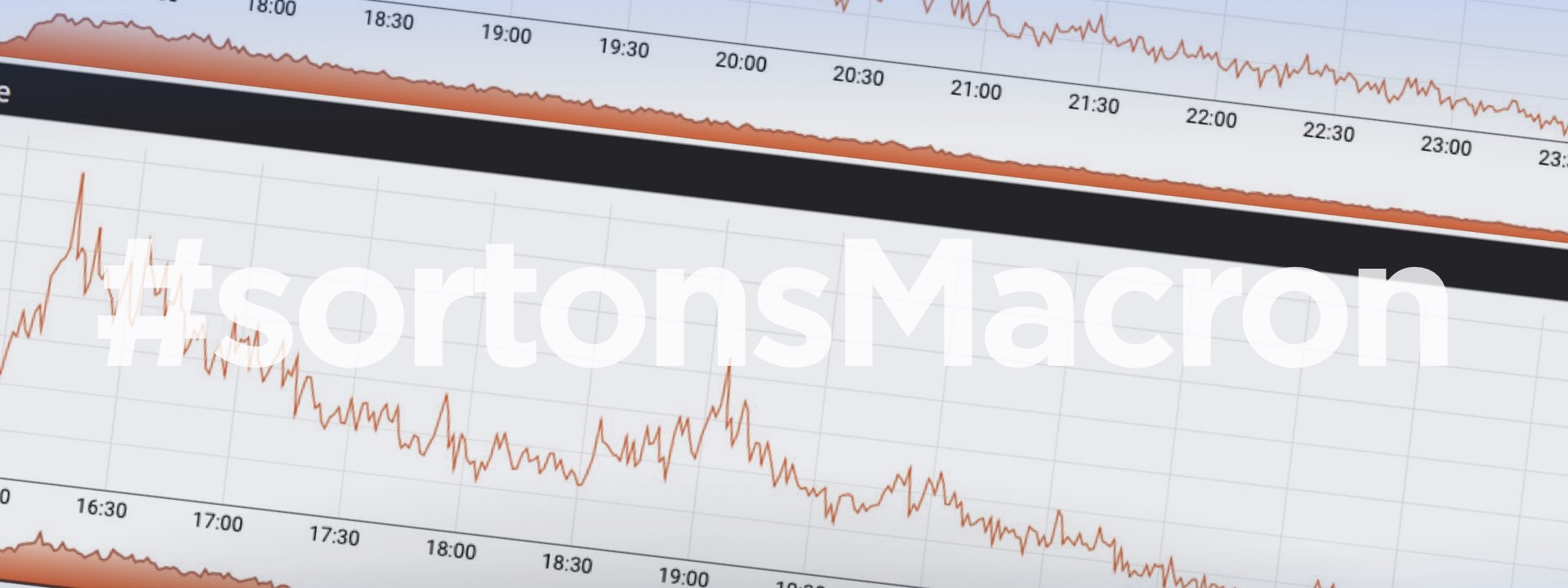
BANNER: Timeline of a machine scan comparing the hashtags #laFrancevoteMarine in February and #sortonsMacron in April.
As France counts down to its decisive presidential election on May 7, the critical question is whether nationalist candidate Marine Le Pen will be able to overturn the sweeping poll lead of her rival, centrist Emmanuel Macron, who is ahead by a reported 20 points.
To have any chance of victory, Le Pen will have to break out from her traditional nationalist support base and appeal to a broader spectrum of voters. She has certainly attempted to do so, stepping down as leader of the nationalist Front National and blurring her stance on whether to keep the euro.
In parallel, her most fervent online supporters have launched a series of hashtag drives intended to boost her image and denigrate Macron.
As in earlier cases documented by the DFRLab, these have been carefully planned and coordinated and have succeeded in making the hashtags trend. However, our latest research suggests they have failed to break out of the pro-Le Pen support bubble to reach a broader public.
This is only a small facet of France’s larger political battle, but it adds to a growing body of evidence suggesting that Le Pen is yet to find the elusive breakthrough.
The campaigns
This report focuses on two hashtag campaigns launched by Le Pen’s online supporters following the first round of presidential voting on April 23: #sortonsMacron (let’s get Macron out), launched on April 25, and #rejoignezMarine (join Marine), on April 30.
To judge the success of the campaigns, we’ve compared them with three hashtag drives launched by Le Pen supporters in February: #Marine2017, launched on February 14; #lepionMacron (Macron the pawn), launched on February 21; and #laFrancevoteMarine (France votes for Marine), launched on February 26.
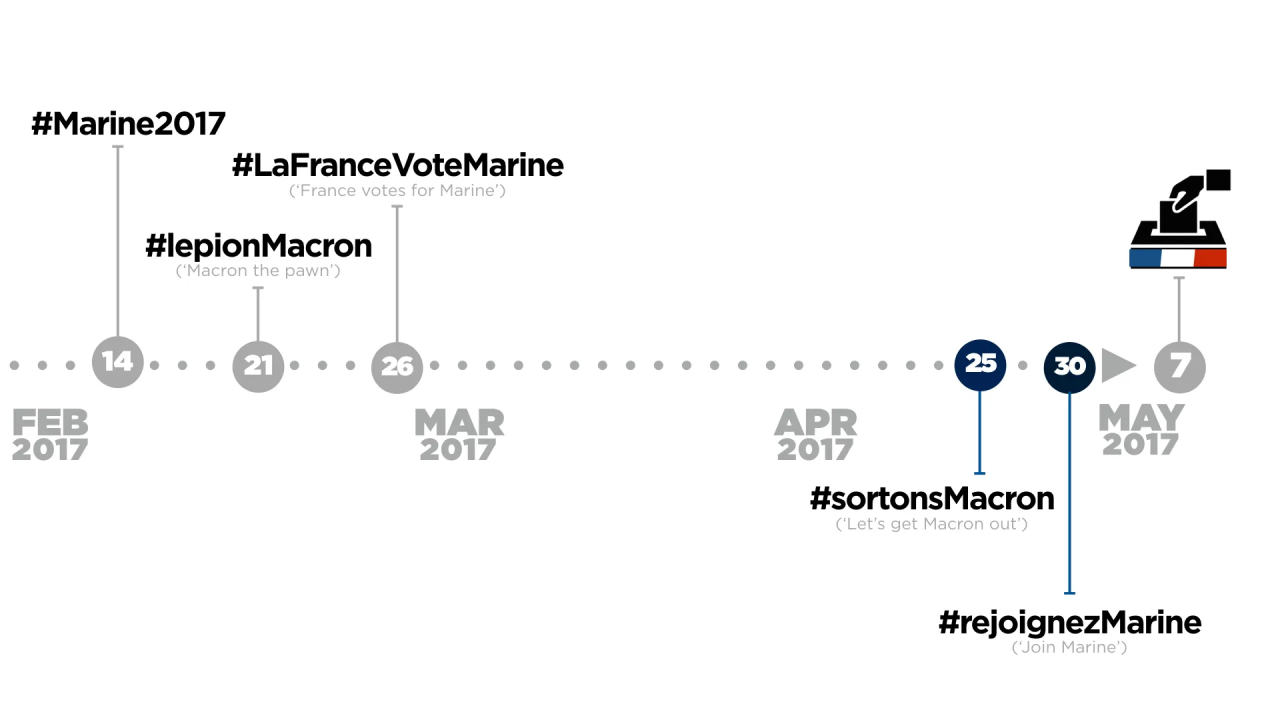
“Success” will be measured in terms of whether the April hashtags performed better than their February counterparts, either by being tweeted more often, trending for a longer period, or being shared by significantly more accounts.
The technique
These hashtag campaigns used a standard technique. A cluster of key accounts — @audreypatriote, @avec_marine, @messsmer and @Dormez_Dormez — launched them with almost simultaneous posts shortly before 6:00 pm French time (in February, 17:00 UTC; in April, 16:00 UTC).
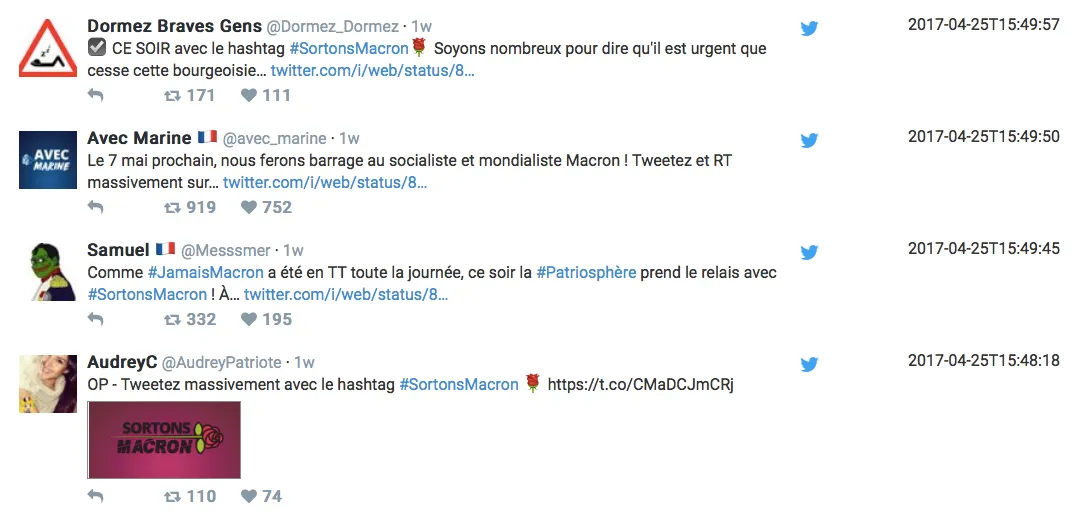
These accounts went on to post individual memes and retweet one another, while an amplification network, including probable automated “bot” accounts, retweeted them further, allowing them to generate tens of thousands of tweets in a few hours. The following sample posts indicate how the lead accounts shared memes, but posted their own texts:
https://twitter.com/Messsmer/status/856898029231759361https://twitter.com/AudreyPatriote/status/856897664260165632
https://twitter.com/AudreyPatriote/status/856947182636851202https://twitter.com/Dormez_Dormez/status/856903238641233920
This highly planned and coordinated activity generated a rapid spike in posts, allowing the leaders to claim success in making their hashtags trend:
However, being listed as a trend is a meaningless victory unless it leads to substantially greater Twitter traffic which reaches a broader audience — which is what Le Pen’s supporters need to do if they are to win.
To assess the hashtags’ reach, the DFRLab conducted a machine scan of all tweets mentioning them from the moment of their launch until seven hours later (a time period chosen to cover the February posts from 17:00 UTC to midnight, and maintained for the April posts for consistency), counting the overall number of tweets generated in that period, and the number of users who posted them:
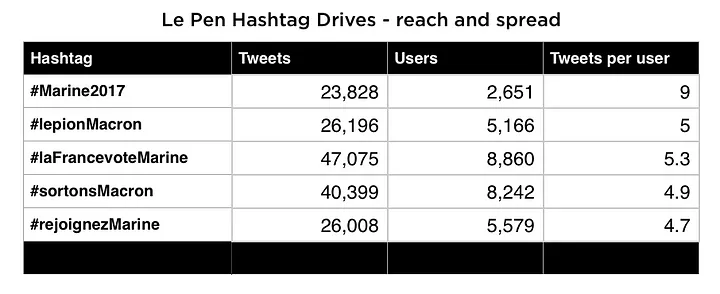
The most-used hashtag was #laFrancevoteMarine, on February 26, with just over 47,000 tweets in seven hours. #SortonsMacron, two months later, came in second, on just over 40,000 tweets. The February campaign on #lepionMacron and the April campaign on #RejoignezMarine both hit just over 26,000 tweets, and #Marine2017 reached almost 24,000.
This shows that, in absolute numerical terms, the pro-Le Pen group’s April campaigns were marginally less effective in generating tweets (and thus support) than the February ones were.
Nor do they appear to have attracted substantially more users. Here, too, #LaFranceVoteMarine drew the largest crowd, with almost 8,900. #SortonsMacron once more came in second, with 8,200. #RejoignezMarine, on almost 5,600, was marginally more effective than #lepionMacron, on almost 5,200.
The April campaigns did perform marginally better than the February ones in terms of the number of tweets per user. This rate is a useful indicator of the extent to which a given hashtag is driven by a small group of dedicated users, or a broader group. The higher the average number of tweets per user, the narrower the interest group.
In this regard, the two April hashtags did reach a broader base than the February ones. However, the improvement was slight, indicative of a marginal improvement at best: certainly not the kind of expansion Le Pen needs to overturn her deficit.
Impact
It is also important to measure the impact of the campaigns, in terms of whether they were picked up by a broader community. This can be visualized by comparing timelines of their performance.
Since #lepionMacron and #rejoignezMarine achieved almost identical numbers of posts, and #laFranceVoteMarine and #sortonsMacron achieved similar figures, it is appropriate to compare them.
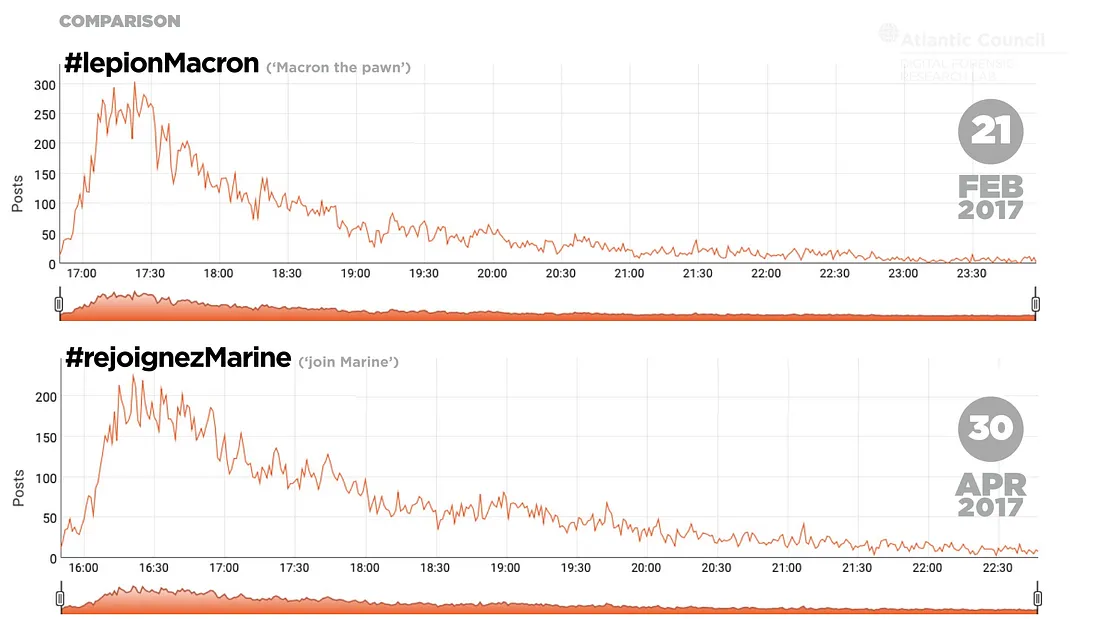
The timelines of #lepionMacron and #rejoignezMarine show a very similar evolution. Both launched shortly before 6pm French time and spiked very rapidly, hitting a maximum rate of some 300 tweets a minute for #lepionMacron, over 200 a minute for #rejoignezMarine.
Within an hour, the rate had dropped back to half the peak. The decline continued at an almost identical rate for both campaigns, until within four hours, traffic was barely a tenth of the peak, and trending steadily lower.
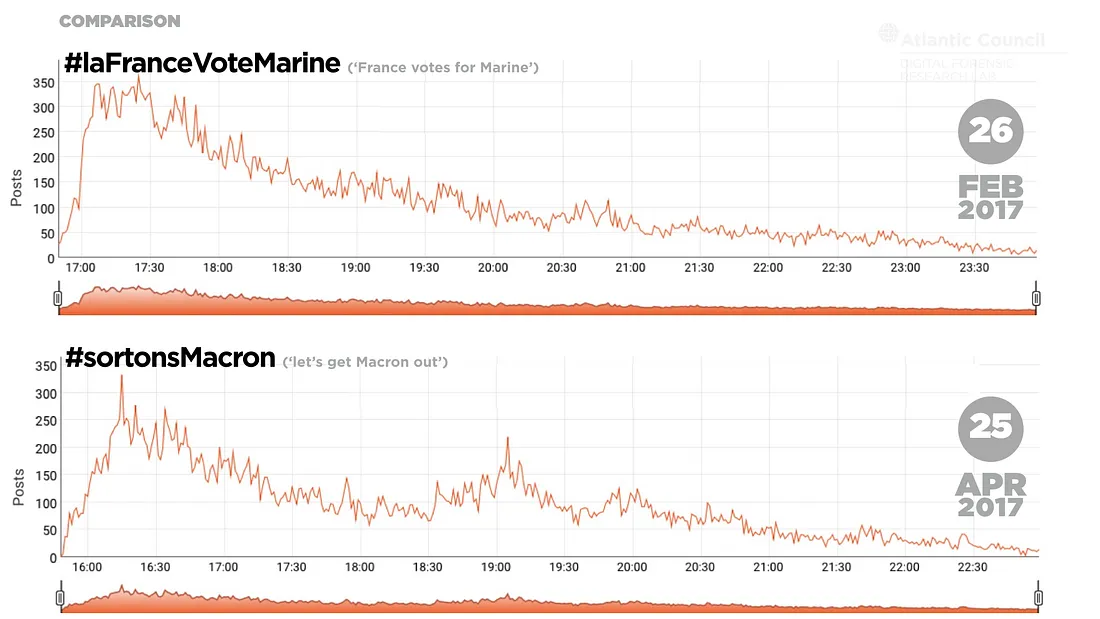
Much the same can be said of #laFrancevoteMarine and #sortonsMacron. Both saw a precipitous climb towards a rate of 350 tweets a minute within the first quarter hour. Both then declined steadily, dropping back to half the original rate after an hour and a half. #sortonsMacron enjoyed a secondary surge around 19:00 UTC, but in both cases, five hours after the launch, traffic was down to one tenth of the original.
These remarkably consistent figures show two things. First, the explosive growth of the hashtag in the first quarter hour is characteristic of a campaign driven by automated accounts. Its ability to trend so rapidly is a tribute to the organization of the Le Pen supporters, but it does not show the steady and organic growth characteristic of genuine grassroots movements.
Second, the hashtags succeeded in being listed as “trending,” but they did not create a trend. Only #sortonsMacron saw a secondary surge after the initial push, and that was limited. In every case, in a few hours’ time, the hashtags had all but ceased their traffic.
Thus in terms of the key challenge — breaking out of the existing cluster of amplifiers to attract new ones — the April hashtag drives did no better than the February ones.
The amplifiers
Final confirmation of this can be gathered from an examination of the most active accounts involved in posting on the hashtags. Time and again, the same accounts emerge, many of then tweeting at inhuman speeds of hundreds of posts an hour.
For example, the account @gab01230 was the second most active tweeter of the hashtag #laFrancevoteMarine, posting 303 tweets on the subject between 16:00 and 18:00 UTC. The same account hypertweeted on #lepionMacron (175 posts in two hours), and was the fourth most prolific tweeter on #rejoignezMarine (206 posts).

Similarly, the account @patriologue posted 181 tweets in the first two hours on #lepionMacron, 188 in the same period on #laFrancevoteMarine, 238 on #sortonsMacron and 254 on #rejoignezMarine.
Every single one of @patriologue’s posts was a retweet; 95 per cent of @gab01230’s were. This indicates that they are probably automated “bots,” set up to amplify others’ messages without the need for a human user.
Some of the most active accounts have already been identified by the DFRLab as probable bot amplifiers in other areas. @heelleclech, for example, which posted hundreds of tweets on #lepionMacron, #sortonsMacron and #rejoignezMarine, is also a major amplifier of Kremlin broadcaster RT in French.
@CHRISTINA2A12, which posted 98 retweets in two hours on #rejoignezMarine, was an amplifier of an unsuccessful hashtag drive launched by a Russian nationalist, #dislikeMacron, just before the April 23 first-round vote. This account uses actress Sandra Bullock as its avatar and gives no verifiable personal information, reinforcing the impression that it is a fake account set up to amplify others.
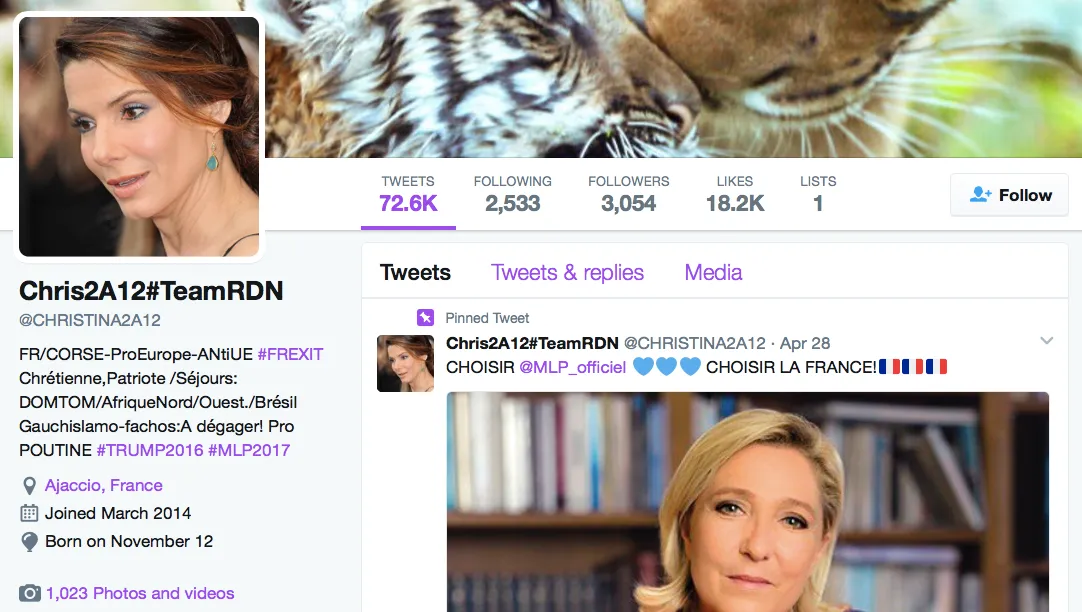
Overall, therefore, these most active amplifiers appear to constitute a stable and self-reinforcing community, boosting the hashtag drives and making them trend, but not breaking out into substantially new online communities.
Conclusion
Le Pen’s online supporters are extremely well organized and capable. They have shown their ability by repeatedly managing to make their hashtags trend, and by organizing the posting of hundreds of tweets a minute for at least brief periods.
However, it does not appear that their efforts have generated significantly more online support over the course of the election campaign. Of the five campaigns studied for this article, #laFrancevoteMarine recorded the highest number of tweets and users, at the end of February. Neither April campaign studied for this report performed as well.
There is no evidence to suggest that any of the hashtags studied here spread significantly beyond the community of Le Pen’s online supporters. They did make it into the overall trending lists, but they did not become self-sustaining trends. Instead, they faded away within a few hours.
Yet Le Pen’s political challenge is precisely to broaden her support beyond her existing community. Social media analysis can only provide a glimpse of the larger political picture; but judging by that glimpse, Le Pen is yet to make the kind of breakthrough that would usher her to victory.

